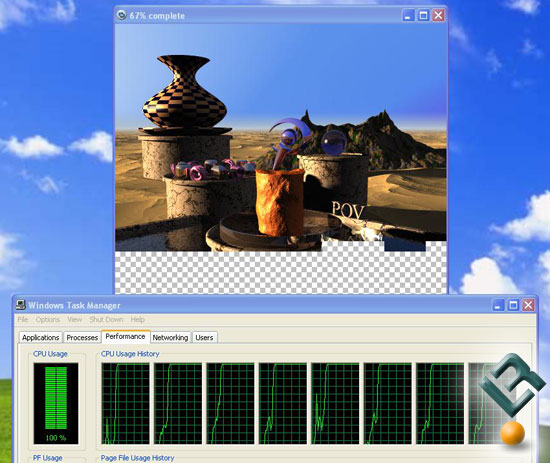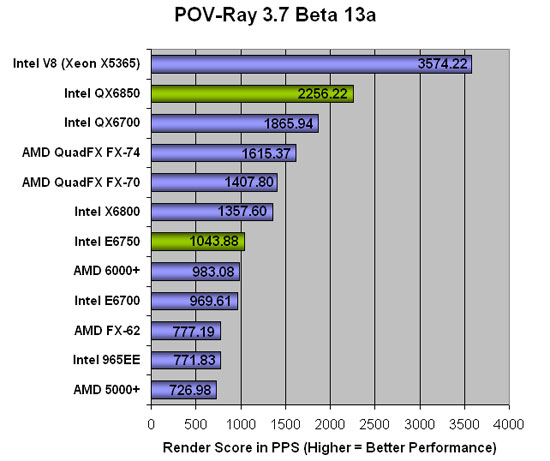Intel 1333FSB Processors Arrive – QX6850 and E6750
POV-Ray 3.7 Beta 13a
Processor Performance on Pov-Ray 3.7 Beta 13a:
The Persistence of Vision Ray-Tracer was developed from DKBTrace 2.12 (written by David K. Buck and Aaron A. Collins) by a bunch of people (called the POV-Team) in their spare time. It is an high-quality, totally free tool for creating stunning three-dimensional graphics. It is available in official versions for Windows, Mac OS/Mac OS X and i86 Linux. The POV-Ray package includes detailed instructions on using the ray-tracer and creating scenes. Many stunning scenes are included with POV-Ray so you can start creating images immediately when you get the package. These scenes can be modified so you do not have to start from scratch. In addition to the pre-defined scenes, a large library of pre-defined shapes and materials is provided. You can include these shapes and materials in your own scenes by just including the library file name at the top of your scene file, and by using the shape or material name in your scene. Since this is free software feel free to download this version and try it out on your own.
The most significant change from the end-user point of view between versions 3.6 and 3.7 is the addition of SMP (symmetric multiprocessing) support, which in a nutshell allows the renderer to run on as many CPU’s as you have installed on your computer. This will be particularly useful for those users who intend on purchasing a dual-core CPU or who already have a two (or more) processor machine. On a two-CPU system the rendering speed in some scenes almost doubles. For our benchmarking we used version 3.7 as all of the processors we are testing today are dual-core.

Once rendering on the object we selected was completed, we took the score from dialog box, which indicates the average PPS for the benchmark. A higher PPS indicates faster system performance.

Looking at the overall render score, the winner is clear by a long shot. The pair of Intel quad-core Xeon X5365 processors blow the other processors away and more than doubles the performance levels seen on the AMD QuadFX platforms. The new Intel QX6850 scored 391 points higher (24%) than it’s little brother, the QX6700. The Intel E6750 out performed the E6700 by 74 points (8%), which shows what one would expect when moving from a FSB of 1066 to 1333MHz.

Comments are closed.